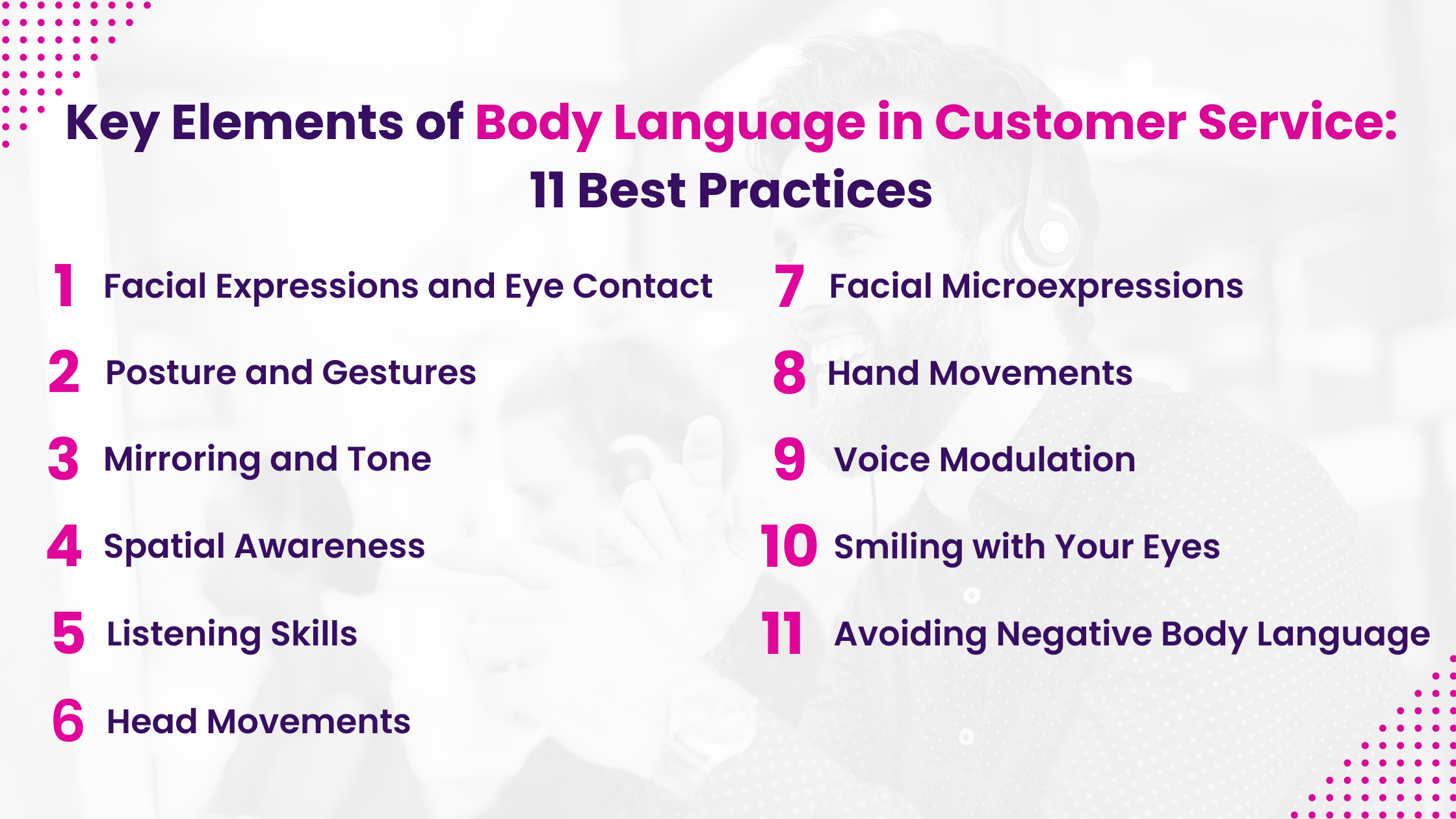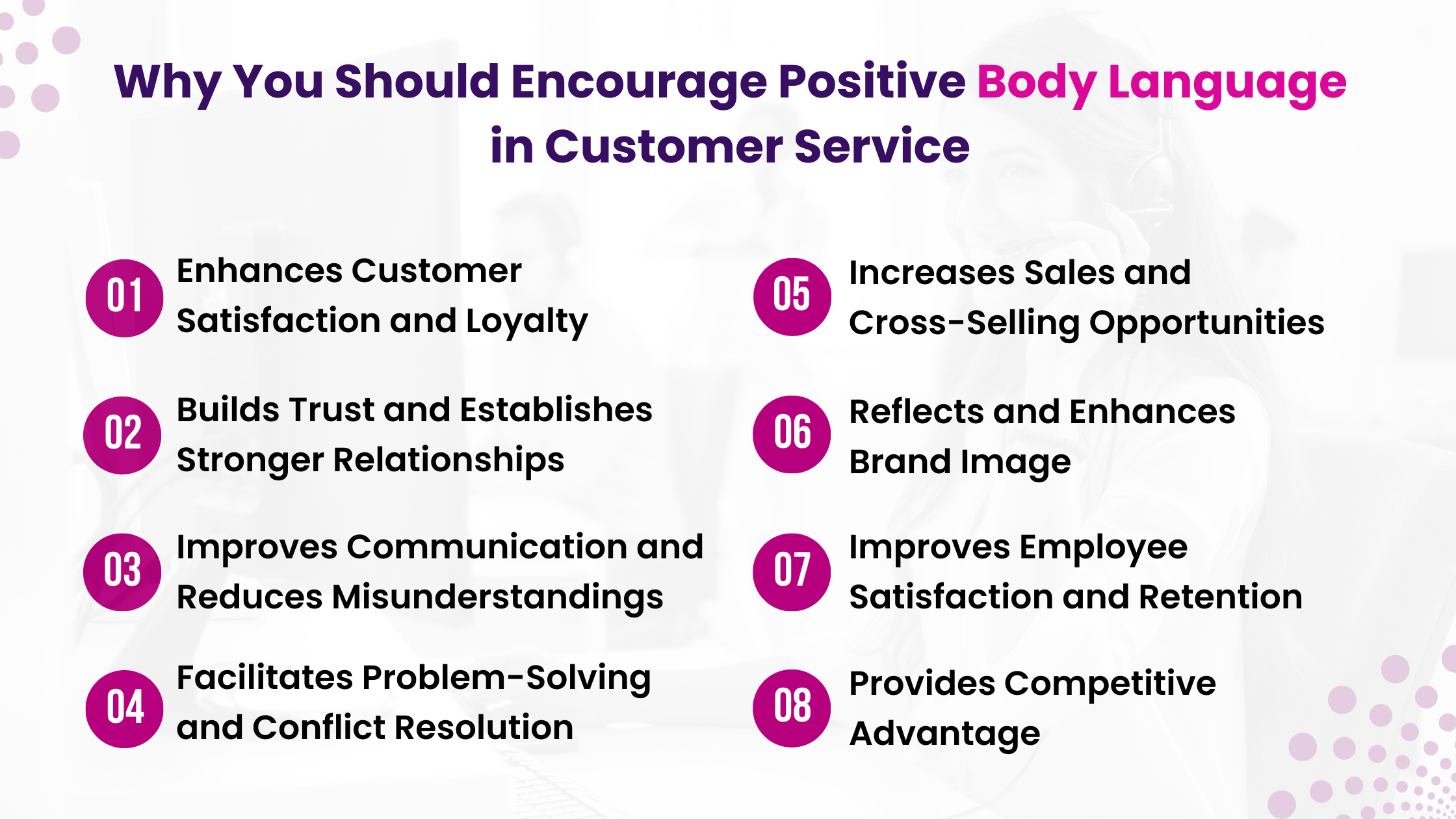If you’re managing a business and aiming for exceptional customer service, understanding the role of body language in customer service is essential. While the words we use in customer interactions are crucial, the way we express them through our body language is equally significant.
Albert Mehrabian, a renowned researcher in body language, discovered that 55% of communication is nonverbal, 38% is based on tone of voice, and only 7% relies on the actual words. This is akin to an iceberg, where the words are just the tip above water, but beneath lies the vast expanse of body language.
This encompasses our movements, facial expressions, and even our posture. Interestingly, body language can drastically alter the perceived meaning of our words. For instance, if a service representative claims they’re happy to assist but appears disinterested or irritated, their words lose credibility.
For businesses striving to excel in customer service, acknowledging the impact of body language in customer service is vital. It’s a powerful tool that can reshape customer interactions, making them feel understood, appreciated, and genuinely cared for.
Effective and congruent body language in customer service can elevate even routine exchanges, building a rapport and trust. On the flip side, inconsistent body language might lead to misunderstandings or doubts about the authenticity of the service.
If your team is new to the concept of body language, there’s no need to worry. The beauty of body language skills is that they can be learned and refined. Being aware of and controlling one’s gestures, facial expressions, and overall presence can greatly enhance the customer service experience.
In this blog, we’ll explore the pivotal role of body language in customer service. We’ll uncover techniques for mastering this crucial non-verbal element and show how it can revolutionize your business environment, leading to more impactful and positive customer engagements.
Key Elements of Body Language in Customer Service: 11 Best Practices

Incorporating effective body language in customer service is not just beneficial; it’s essential for creating a positive and impactful customer experience. Here are 11 best practices, each integral to mastering body language in customer service:
1. Facial Expressions and Eye Contact: A genuine smile and appropriate eye contact are foundational in body language in customer service. They convey empathy and understanding, making the customer feel valued. Maintaining eye contact signifies that you are fully engaged and attentive to the customer’s concerns.
2. Posture and Gestures: Adopting an open and confident posture is a key element of body language in customer service. An upright stance with a slight forward lean shows engagement and interest.
Controlled gestures, such as open hands, can emphasize communication effectively, while avoiding gestures that may seem closed off or defensive.
3. Mirroring and Tone: Mirroring the customer’s body language subtly in customer service can create a sense of rapport and understanding. The tone of voice should be adapted to fit the context of the conversation, as it can convey various emotions and intentions, enhancing the overall customer interaction.
4. Spatial Awareness: Understanding and respecting personal space is crucial in body language in customer service. The appropriate distance varies depending on cultural norms and individual preferences, but finding a comfortable balance is key to not appearing too intrusive or detached.
5. Listening Skills: Active listening is a vital component of body language in customer service. It involves more than just hearing words; it includes nodding in agreement, leaning in slightly, and using verbal affirmations to demonstrate that you are fully engaged and value what the customer is saying.
6. Head Movements: In customer service, appropriate head movements like nodding can signify agreement and understanding, while shaking the head might indicate confusion or disagreement. These movements can reinforce the verbal message and enhance clarity in communication.
7. Facial Microexpressions: Paying attention to facial microexpressions is important in body language in customer service. These brief, involuntary expressions can reveal true emotions and intentions, offering deeper insight into the customer’s feelings and enhancing the ability to respond appropriately.
8. Hand Movements: The use of hands is a powerful aspect of body language in customer service. Open palm gestures suggest honesty and openness, while pointing or closed fists can be perceived as aggressive or confrontational. It’s important to use hand movements that align with positive and clear communication.
9. Voice Modulation: Modulating your voice in terms of pitch, tone, and volume is a key practice in body language in customer service. It keeps the customer engaged and makes the interaction more dynamic and empathetic, adapting to the nuances of the conversation.
10. Smiling with Your Eyes: A genuine smile that reaches the eyes, often called a ‘Duchenne smile,’ is a critical aspect of body language in customer service. It conveys authenticity and warmth, making the customer feel more at ease and connected.
11. Avoiding Negative Body Language: In customer service, it’s important to avoid negative body language, such as crossing arms, rolling eyes, or constantly checking the clock. These actions can signal disinterest or impatience, negatively impacting the customer’s perception of the service.
By focusing on these key elements and best practices of body language in customer service, professionals can significantly enhance the effectiveness of their customer interactions, leading to improved satisfaction and loyalty.
Why You Should Encourage Positive Body Language in Customer Service

The impact of body language in customer service extends beyond basic interactions, providing a range of tangible benefits to businesses:
1. Enhances Customer Satisfaction and Loyalty: Effective body language, like a genuine smile and attentive posture, creates a welcoming environment. This positive engagement is linked to increased customer satisfaction, which is crucial for customer loyalty.
Satisfied customers are more likely to return and recommend the business to others, driving repeat business and new customer acquisition.
2. Builds Trust and Establishes Stronger Relationships: Trust is a cornerstone of customer service. Positive body language, like maintaining eye contact, nodding in understanding, and mirroring customer gestures, fosters a sense of trust and rapport.
This is particularly vital in industries with key long-term customer relationships, like banking or healthcare.
3. Improves Communication and Reduces Misunderstandings: Non-verbal cues complement and reinforce verbal communication. Effective body language can, therefore, help clarify messages and reduce misunderstandings, leading to more efficient and effective customer interactions.
4. Facilitates Problem-Solving and Conflict Resolution: Understanding and appropriately responding to customers’ non-verbal cues can lead to quicker and more effective problem resolution.
This skill is particularly valuable in high-stress situations, where body language can defuse tension and promote a solution-focused discussion.
5. Increases Sales and Cross-Selling Opportunities: In sales, positive body language can be a persuasive tool. For instance, confident posture and enthusiastic gestures can enhance a sales pitch, making the product or service more appealing. This can lead to increased sales and opportunities for cross-selling.
6. Reflects and Enhances Brand Image: Consistent and positive body language across customer service interactions strengthens the brand’s image. It conveys professionalism and a customer-centric approach, aligning with and enhancing the company’s brand values.
7. Improves Employee Satisfaction and Retention: Training in body language not only benefits customers but also employees. When staff are confident in their non-verbal communication skills, it can increase job satisfaction and lower turnover. This is important because employee turnover can be costly for businesses.
8. Provides Competitive Advantage: In a market where products and services are often similar, excellent customer service, enhanced through effective body language, can provide a competitive edge. It differentiates a business in the eyes of the customer, making it stand out from competitors.
Practical Tips for Positive Body Language in Customer Service
Implementing positive body language in customer service can significantly enhance the customer experience. Here are some practical tips:
- Practice Maintaining Eye Contact: Start by practicing with friends or colleagues. Aim for a balance where you look at them while they speak, but remember to break eye contact to prevent staring occasionally.
- Role-Play Open Body Posture: Engage in role-playing exercises that focus on maintaining an open posture – practice scenarios without crossing arms or creating barriers with objects. Use a mirror or video recording to self-evaluate and adjust.
- Smile and Nod Exercises: Consciously practice nodding and smiling appropriately in conversations. You can do this in everyday interactions to make it a habit. Be mindful of your smile’s authenticity; it should reach your eyes.
- Mirroring Practice: Observe and subtly mimic the body language of friends or colleagues in a non-customer service setting to get comfortable with this skill. Remember, the key is subtlety.
- Gestures Reinforcement: Watch videos of effective communicators and notice how they use hand gestures. Practice incorporating similar gestures into your customer interactions, ensuring they align with your words.
Unlock Customer Service Excellence with INSIDEA’s Expertise!

Are you ready to transform your customer service and take your customer experience to the next level? INSIDEA is here to guide you through every step of the way, ensuring that your support team is empowered to deliver exceptional service.
As experts in customer support solutions, we pride ourselves on helping businesses optimize their support strategies for maximum efficiency and customer satisfaction. Reach out today to discover how INSIDEA can revolutionize your customer support and contribute to your business success!
Tailored Support Strategies: At INSIDEA, we understand that every business is unique. That’s why we work closely with you to develop customized support strategies that align with your specific needs and goals.
Industry Expertise: Our team brings a wealth of experience and industry knowledge to the table, ensuring that you have access to the best practices and insights in customer support.
Customer Commitment: Your customers’ happiness is our top priority. We are dedicated to helping you exceed their expectations and foster long-lasting relationships.
Ready to elevate your customer support experience? Book a meeting with our experts today and start your journey towards outstanding customer service and satisfaction.








































